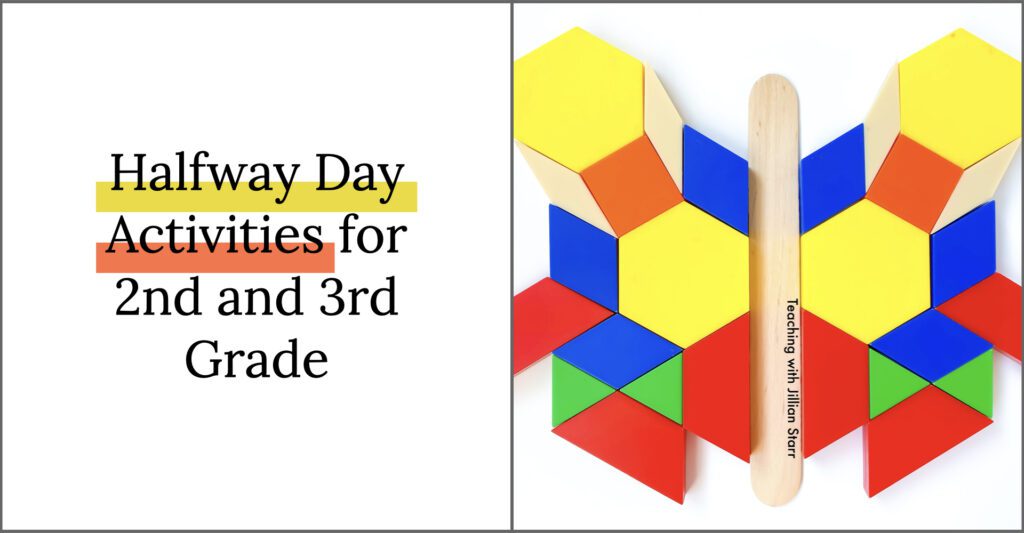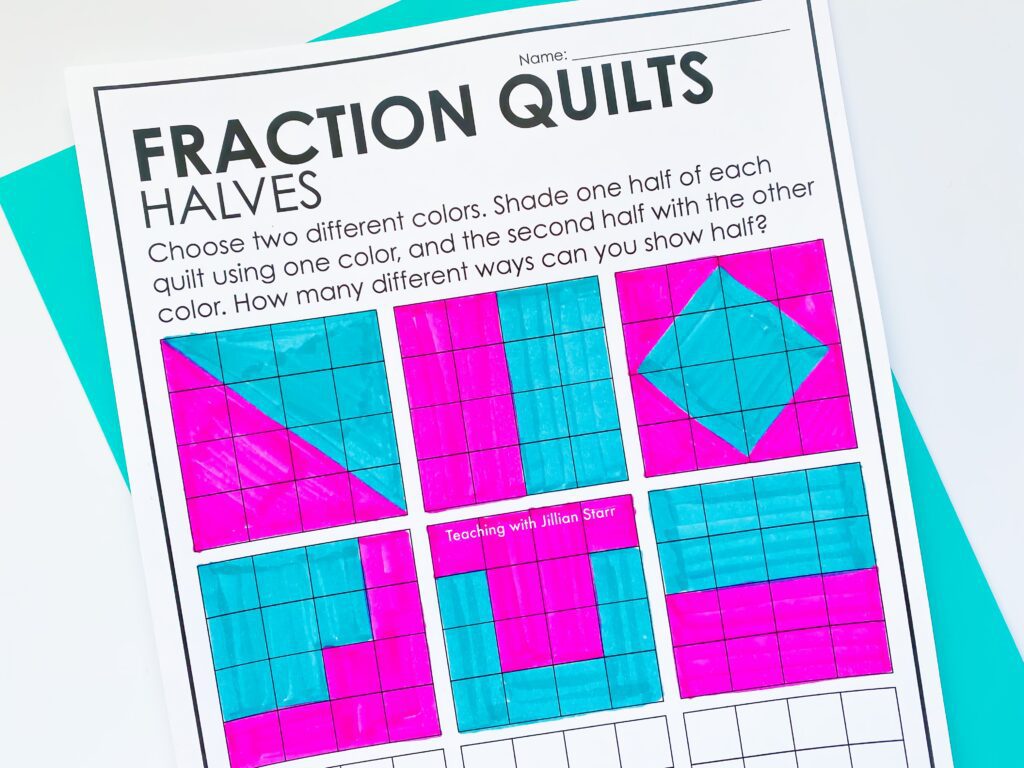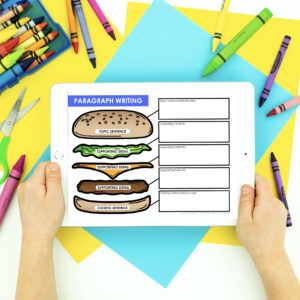
I have a question for you: After winter break when you have settled back into routines and made resolutions, do you ever find yourself wishing you had something special to wipe away the January blues? Look no further! While not as commonly celebrated as the 100th day, Halfway Day has always been a go-to day of celebration in my classroom. Sure, the 100th day is just around the corner. But halfway day activities are another way to get students excited about their progress and mathematical concepts.
I’ve gathered all of my favorite Halfway Day activities in this post. There are a lot of Halfway Day activities that I’ve tried and loved. Don’t worry about fitting them all into one day. You can always incorporate Halfway Day activities into your daily routine or spread them out throughout the week– halfway week!
Symmetry-Based Halfway Day Activities
Fun with symmetry is a great way to emphasize mathematical thinking in art and the real world. Numerous Halfway Day activities highlight symmetry in their everyday lives. Cue: engagement!
Facial Symmetry
Here is one of the most popular Halfway Day activities I’ve ever implemented: face symmetry activities.
Prep is simple: I take a photo of each student’s face directly head-on. Then, I fold or cut the photo at the vertical halfway line down their face.
A brief mini-lesson introduces the activity and the concept of symmetry. I show students what each side of a face looks like when split vertically. Quickly, students note that the two sides of the face are the same. They define symmetry!
With the half-photo glued to another piece of paper, each student draws the other half of their face. Their aim is to make it as symmetrical as possible.
This Halfway Day activity is challenging, takes some patience, but is oh so rewarding. Students end the activity with a more robust understanding of symmetry.
Working with Object Symmetry
Another great way to include student interests in Halfway Day activities is by emphasizing their favorite objects! Print out objects that you think will excite your students—for example, print soccer balls and cleats for students who love soccer. Then, draw a line at the vertical or the horizontal halfway point (depending on the object). Ask students to draw the other half.
Build-Your-Own Symmetry Activity

Are your students ready for a mind-boggling challenge? Another one of my favorite ways to explore symmetry is through math manipulatives!
Let them build! Place a ruler down on the table and ask them to build a symmetrical image out of pattern blocks. You can increase or decrease the challenge level by adjusting the difficulty of the parameters. For example, you can change the number of pattern blocks they must use or the number of types of pattern blocks that must be included.
You can also make this activity collaborative! Once students get the hang of building symmetrical images, you can take the activity a step further. In partners, students will create half an image. Then, the partners swap. The partner tries to create the other half of their peer’s manipulative masterpiece.
Celebrate Halfway Day With Measurement
When it comes to math, my motto is always: bring it back to the real world. We constantly measure in halves every day. Use Halfway Day to emphasize it through measurement-based activities.
Measuring Time
Time is a massive part of our math scope and sequence through third grade. Halfway Day is when many of us break out our favorite time activities. Two of my favorites are Elapsed Time Race and Kaboom!
- Elapsed Time Race is one of my favorite math centers to practice elapsed time. While there are many different versions, I use the hour and half-hour version on Halfway Day.

How does it work? Two players begin with two decks of cards. One deck has clock faces indicating a specific time. The other deck has the amount of elapsed time. Player one starts by turning over one card from each deck. They must add or take away that amount of time from their starting time. Then, it is the second player’s turn.
- Another favorite is Time Kaboom! If you haven’t yet played it with your class, do it right now!

Played in a group, students take turns pulling out a popsicle stick with either a clock face or an elapsed time problem. The student must identify the time correctly. Students continue pulling one popsicle stick at a time, answering each question. If students pull out a stick that says “Kaboom!”, they have to put all of their sticks back. I promise– it is a lot less harsh than it sounds! And so much fun!

Time Centers Mega Pack
Measuring Distance + Length
In the middle of a measurement unit? Use halfway day to measure length and distance!
Practice measuring wholes and halves. With rulers and measuring tapes (gotta have your tools!), explore measurement of whole objects and half objects. With a simple recording sheet, students measure objects around the classroom. They measure the whole, record it. Then, they determine how much is half. An extension and challenge is to ask students to measure to the half unit.
Area + Array Activities
Another critical measurement to slice in half: area. On Halfway Day, I challenge my students to think about the connection between multiplication and division through ARRAYS.
This next activity challenges students to think about division. It provides an opportunity to visually explore halves. Students start by building whole arrays with math manipulatives. They record their whole product. Then, they divide their whole into two equal parts, finding half. The big question: Is it possible? Not always!
I usually ask students to record their work in equations and visuals. I ask them to show both the whole and the half versions in their math journal. That way they can refer back to it as we go deeper into multiplication, division, and fraction units.
Halfway Day and Fractions
Halfway day is the perfect moment to start introducing fractions. Whether or not it is your current unit, the activities and exposure to fractions at the midpoint of the year can be so beneficial.
Fraction Quilts

Fraction quilts are a fun, creative fraction math center to introduce the idea of a half. Students receive a worksheet with nine 4×4 arrays—their mission: color in half of the squares in each array. Find as many ways as possible to make half.

FRACTION MEGA PACK
Folding Paper Equivalent Fractions
Sometimes the best activities are those that involve ZERO prep. That’s where the folding paper activity comes to the rescue. There are two ways I’ve approached this activity.
Approach #1:
Each student receives a blank white paper and four markers uniquely colored (I like using red, blue, yellow, and green). The instructions are as follows:
- Fold the paper in half.
- Color in one half of the paper and leave the other half blank. Set that color aside.
- Fold the blank side in half and make two ¼ sections.
- With a second color, color the ¼ section that borders the colorful half.
- This process continues to show eighths and sixteenths.
Approach #2:
Each student receives multiple pieces (4) of blank white paper.
- The first sheet is folded into two halves. Students draw a line at the creases and write ½ in each section.
- The second sheet is folded into two halves. Then, each half is folded in half again, resulting in quarters. Students write ¼ in each section.
- The third sheet of paper is folded into eighths following the same procedure.
- Finally, the fourth sheet of paper is folded into sixteenths.
Literacy Activities for Halfway Day
Halfway Day activities aren’t just for math class. There are many fun ways to bridge the idea of “half” into other subjects. Your literacy block is a great way to think about halves and spark creativity.
Half and Half Stories
My students love read alouds and group reads. Most importantly, they love stories. But what happens when you read just half the story? Where do their imaginations go? I let their imaginations run wild on Halfway Day with a fun “half and half” story activity.
How it begins: I read half of a story to the class. We learn about the characters. We know how the story begins. And we reach the problem or conflict. Then, I leave them on a cliffhanger. As you can guess, many students are troubled. How does the story end?
That’s up to them!
There are two possible next steps:
- Younger students: we brainstorm as a group or as partners. We stay in oral storytelling mode. We share all of our possible ideas.
- Older students: we do an oral brainstorm of possible structures. Then, I instruct students to write versions of the second half.
Half Story Swap
As a child, did you ever play the drawing game where you folded a piece of paper into three sections and collaborated on a mystery monster? Artist #1 drew the head, neck, and shoulders. Next, artist #2 drew the torso to the hips. Finally, artist #3 drew the legs and feet. In the end, you had a wildly creative (and hilarious) creature.
Half Story Swap has a similar premise. I provide students with a very simple story arch and characters. One student or partnership creates a story leading up to the problem. The other student or partnership (without seeing the first half of the story)finishes the story. They write from the problem through the solution to the end.
The activity ends in utter silliness!
Customize this to your student’s abilities and needs:
- Instruct students to do this orally
- Practice using graphic organizers to structure storytelling
- Practice using a story arc visualizer
- Instruct students to write out a rough draft, practicing quick writing!
Half and Half Idioms

Another fun Halfway Day activity for your literacy block is an exploration of idioms. Side note: I have so much fun prepping and watching this one unfold!
First, I gather as many idioms as possible and cut them in half. For example, “When it rains, it pours” becomes“when it rains.” Then, students decide what the second part of the idiom will be and what it means!
This activity is fun any time of the year. It also really helps students understand the purpose of idioms and figurative language. Yes, it is a great way to introduce popular American idioms to ELL students.

AN INTRODUCTION TO IDIOMS
The most important part of developing a Halfway Day set of activities: have fun! Many of these ideas are easy, no-prep projects. Many of these projects can continue throughout the year. Perhaps your mind started churning as you read this post as well. I’d love to hear your creative ideas about Halfway Day activities!











Leave a Comment